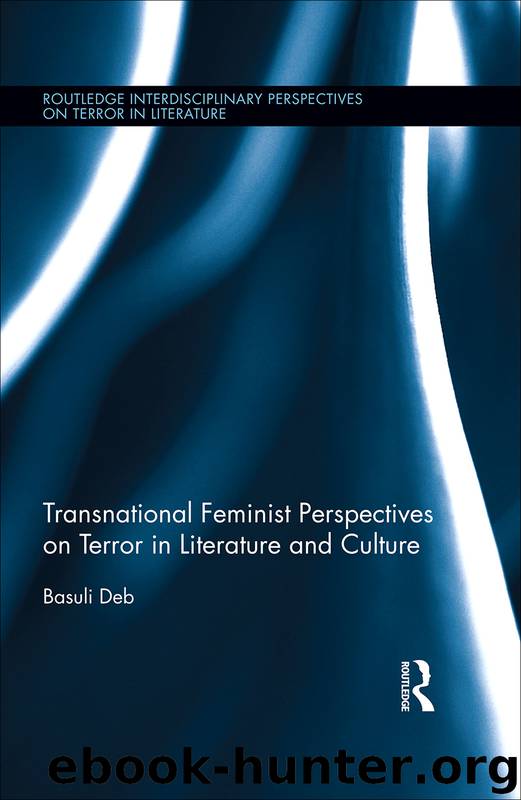Transnational Feminist Perspectives on Terror in Literature and Culture by Deb Basuli;

Author:Deb, Basuli;
Language: eng
Format: epub
Publisher: Taylor and Francis
Published: 2015-03-14T16:00:00+00:00
ARCHIVING THE GENDER POLITICS OF GENOCIDAL TORTURE AND TERROR
During the Guatemalan Civil War the body of the tortured Mayan woman became a vital site for the militarized nation-state to write its narrative of racism and misogyny with impunity. While mass massacres of indigenous women were not reported in the urban newspapers, Mayan refugee women’s testimonies detail women being raped before loved ones and community members before carnage in villages, public disembowelment of pregnant women, postmortem lacerations, men and women being burnt alive, public beheading, and maiming.46 Close to 90 percent of rapes were committed on Mayan women. Cadaver reports of raped women, or cadavers of raped women strewn across the landscape with “necrographic maps or torture signs,” created a pervasive atmosphere of vulnerability through the terror of the unknowable and the shame of the unspeakable. In this environment Guatemalans became helpless bystanders in the face of a regime of national security rape.47 According to Irene Matthews, “Organized rape plays a special role in a policy of ethnocide; it violates the rules and customs of the group, spreads fear, morally and physically disintegrates the family and the community, and submits women to the most monstrous evidence of the power of violence” (99). The REMHI report has emphasized the gender politics of torture and terror that defined the genocidal character of the counterinsurgency: “It attacked the community social fabric at its foundations by attempting to exterminate women and children in their capacity as vessels for the continuity of life and the transmission of culture” (80). Nevertheless, the Convention against Torture and Other Cruel, Inhuman or Degrading Treatment or Punishment, adopted in 1984, is silent about official rape as a method of torture. The Convention is couched in gendered language that assumes the political subject of state-sanctioned torture to be male.48 Earlier, in 1949, Article 27 of the Fourth Geneva Convention, pertaining to the protection of the noncombatant population, coded wartime sexual violence on women in the language of honor rather than torture. The article states: “Women shall be especially protected against any attack on their honour, in particular against rape, enforced prostitution, or any form of indecent assault.”49 By erasing wartime rape as state violence, human rights law and practice privatized political rape as personal acts of sexual depravity by individual men rather than jurisprudentially recognizing it as official violence or torture.50 This continued till 1998 when the Hague International Criminal Tribunal for the former Yugoslavia publicized rape of women as a systematic method of torture by state actors during the Balkan genocide.51 Like rape, forced impregnation has been a powerful ethnocidal tool in the Mayan genocide. Even after the Balkan genocide, rather than being recognized as a war crime in and of itself, forced impregnation was identified as such only to help in framing rape as genocide.52 It was used to underline the power of rape-induced pregnancy as an official policy for fragmenting the target culture. In fact, before the Balkan genocide hearings, forced impregnation was not even juridically acknowledged as a wartime phenomenon.
Download
This site does not store any files on its server. We only index and link to content provided by other sites. Please contact the content providers to delete copyright contents if any and email us, we'll remove relevant links or contents immediately.
| Ancient & Classical | Arthurian Romance |
| Beat Generation | Feminist |
| Gothic & Romantic | LGBT |
| Medieval | Modern |
| Modernism | Postmodernism |
| Renaissance | Shakespeare |
| Surrealism | Victorian |
4 3 2 1: A Novel by Paul Auster(11049)
The handmaid's tale by Margaret Atwood(6852)
Giovanni's Room by James Baldwin(5878)
Big Magic: Creative Living Beyond Fear by Elizabeth Gilbert(4723)
Asking the Right Questions: A Guide to Critical Thinking by M. Neil Browne & Stuart M. Keeley(4574)
On Writing A Memoir of the Craft by Stephen King(4213)
Ego Is the Enemy by Ryan Holiday(3991)
Ken Follett - World without end by Ken Follett(3972)
The Body: A Guide for Occupants by Bill Bryson(3801)
Bluets by Maggie Nelson(3710)
Adulting by Kelly Williams Brown(3670)
Guilty Pleasures by Laurell K Hamilton(3586)
Eat That Frog! by Brian Tracy(3514)
White Noise - A Novel by Don DeLillo(3435)
The Poetry of Pablo Neruda by Pablo Neruda(3367)
Alive: The Story of the Andes Survivors by Piers Paul Read(3310)
The Bookshop by Penelope Fitzgerald(3225)
The Book of Joy by Dalai Lama(3217)
Fingerprints of the Gods by Graham Hancock(3212)
